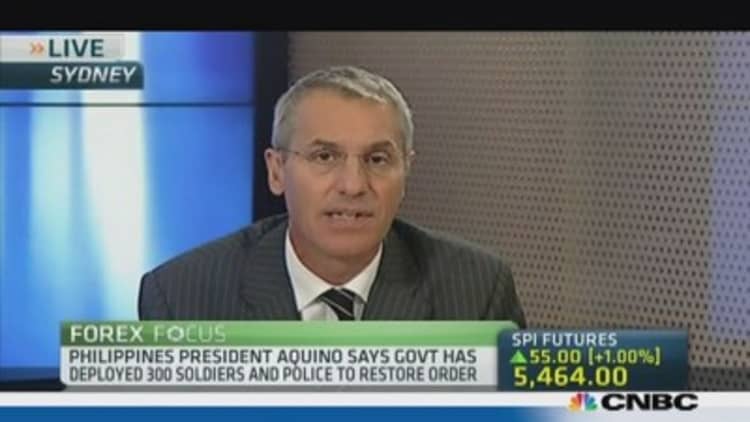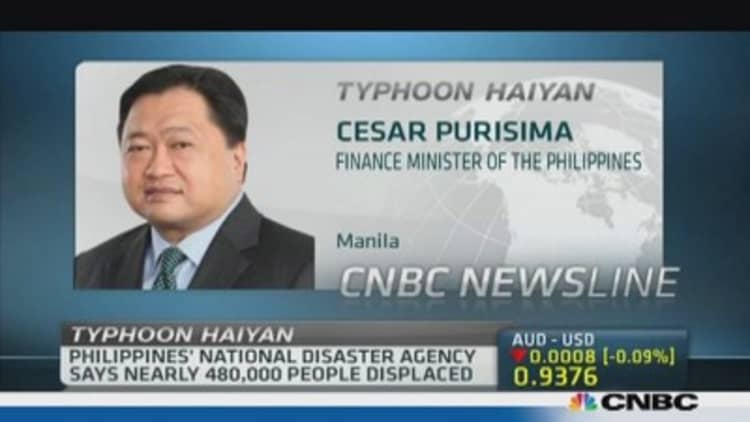
As the Philippines continues to suffer the devastating impact of the worst storm to have ever hit land, analysts have started to weigh up how damaging this tragic event could be on the country's burgeoning economy.
The storm is estimated to have killed up to 10,000 people and destroyed towns and villages across on the island of Leyte and neighboring island Samar, after storm surges as high as trees and wind gust reaching 175 miles per hour ravaged the region.
(Read More: Philippine typhoon kills estimated 10,000)
Since the typhoon made landfall on Friday, the Philippines' domestic currency - the peso - has weakened by 0.3 percent against the dollar to trade at around 43.405. Meanwhile, the Philippine stock market fell 2.2 percent in the first half an hour of trading Monday.
According to PJ Garcia, head of institutional business at BPI Asset Management, the economic impact of the typhoon should be contained to the area of the Philippines most heavily hit and the effect on the rest of the economy should be minimal.
"This is a very unfortunate event. It's unprecedented in terms of the damage done [to the region]...The market will likely, of course, see some correction from here in the short term, [but] in terms of the impacts on earnings for listed companies, I think the impact is not as adverse as the devastation on the ground," he said.
(Read More: Scenes from Philippines' super storm)

Garcia added that the damage to the economy was unlikely to show up in the Philippines' final quarter economic data, but would come through in the first quarter of next year, with the agricultural sector taking the heaviest hit.
The hardest-hit province of Leyte produces a high level of rice and sugar.
"Remember before the super typhoon hit the region, a lot of the farmers were under harvesting period. Unfortunately they got hit before they could harvest their produce and that will affect agricultural output... We expect a one-off spike in inflation at least for November and December as a result of the agricultural losses," he added.
(Watch This: Philippines' Tacloban city ravaged by waves)
However, Garcia added that a silver lining would be the massive infrastructure re-building effort the region would require, and would help offset the damage to growth.
The Philippine economy has bolted ahead in recent years, clocking a 6.6 percent growth last year, with the government targeting a similar level in 2013.
In terms of currency, Ray Attrill, co-head of FX strategy at the National Australian bank, said the Philippines peso was set to suffer a similar plight as the Indonesian rupiah in the aftermath of the 2004 tsunami.
(Read More: Philippines Red Cross: Typhoon is 'overwhelming')
"In that case [the 2004 tsunami] the rupiah did fall about 10 percent in the immediate aftermath... my guess is we are closer to the 2004 tsunami [in terms of similar reaction]... which probably means downward pressure on the peso," he said.
However, Attrill added that he expected the selloff to be short-term, as large-scale foreign aid flowing into the region combined with a likely increase in foreign workers sending extra money back home, which makes up a large part of the Philippines' economy, would likely provide longer term support.
Philippine Finance Minister Cesar Purisma told CNBC on Monday that the typhoon would shave between 8 to 10 percent off the region's gross domestic product next year, and roughly 1 percent of the Philippines's overall growth.
—By CNBC's Katie Holliday: Follow her on Twitter @hollidaykatie


